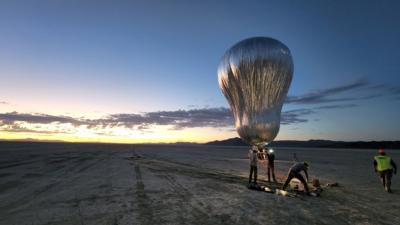Thu, Oct 13, 2022
Atmospheric Assestment System in Development for Venutian Exploration
The Jet Propulsion Laboratory completed the first of a battery of test flights for their prototype aerial robotic balloon.

The system is hoped to help uncover atmospheric conditions on the planet Venus, deploying the balloon into the intense heat, pressure, and corrosive gases found in its environment. The balloon is a part of a concept that pairs it with an orbiting platform outside the atmosphere. The duo would allow the orbiting portion to function as a communications relay while allowing the robotic balloon, or "aerobot" , to descend into the atmosphere proper and act as a submerged analysis platform.
The idea is promising enough for the JPL to begin work on preliminary designs that would see the aerobot make humanity’s best observation of Venus in decades, following up on a balloon-borne survey done underthe Soviet’s Vega mission in 1985. Those balloons lasted only 46 hours before losing power, a record that should be handily outperformed with modern technology - provided, of course, that they’re hardy enough to survive. The ultimate goal for NASA is to create an aerobot that can travel by riding the Venusian winds, circumnavigating the planet for at least 100 days while monitoring the planet with as many sensors as they can pack aboard.
The Jet Propulsion Lab tested the general concept with the assistance of the Near Space Corporation to assess the feasibility of a smaller 1/3 scale demonstrator over Nevada's Black Rock Desert. The test saw the silvery aerobot ascent to 4,000 feet, roughly equivalent to the atmospheric conditions found at 180,000 ft AGL on Venus. The prototype appears to have been a success, ascending and holding altitude before coming back down to earth with the trademark grace of lighter-than-air aircraft.
“We’re extremely happy with the performance of the prototype. It was launched, demonstrated controlled-altitude maneuvers, and was recovered in good condition after both flights,” said robotics technologist Jacob Izraelevitz, who leads the aerobot's development as the JPL principal investigator over flight testing. “We’ve recorded a mountain of data from these flights and are looking forward to using it to improve our simulation models before exploring our sister planet."
More News
He Attempted To Restart The Engine Three Times. On The Third Restart Attempt, He Noticed That Flames Were Coming Out From The Right Wing Near The Fuel Cap Analysis: The pilot repor>[...]
Make Sure You NEVER Miss A New Story From Aero-News Network Do you ever feel like you never see posts from a certain person or page on Facebook or Instagram? Here’s how you c>[...]
From 2009 (YouTube Edition): Leading Air Show Performers Give Their Best Advice for Newcomers On December 6th through December 9th, the Paris Las Vegas Hotel hosted over 1,500 air >[...]
Aero Linx: NASA ASRS ASRS captures confidential reports, analyzes the resulting aviation safety data, and disseminates vital information to the aviation community. The ASRS is an i>[...]
“For our inaugural Pylon Racing Seminar in Roswell, we were thrilled to certify 60 pilots across our six closed-course pylon race classes. Not only did this year’s PRS >[...]
 NTSB Final Report: Rutan Long-EZ
NTSB Final Report: Rutan Long-EZ ANN FAQ: Turn On Post Notifications
ANN FAQ: Turn On Post Notifications Classic Aero-TV: ICAS Perspectives - Advice for New Air Show Performers
Classic Aero-TV: ICAS Perspectives - Advice for New Air Show Performers ANN's Daily Aero-Linx (06.28.25)
ANN's Daily Aero-Linx (06.28.25) Aero-News: Quote of the Day (06.28.25)
Aero-News: Quote of the Day (06.28.25)



